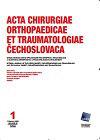在舟状骨骨折中实现最大碎片间压迫的最佳解决方案是一枚还是两枚赫伯特螺钉?
摘要
研究目的:比较一枚和两枚赫伯特螺钉(HBS)固定舟状骨骨折的治疗效果。材料与方法72例急性舟状骨骨折患者行切开复位内固定(ORIF),由一名外科医生进行前瞻性随访。所有骨折均为Herbert & Fisher分类B型,最常见的骨折线为斜向(n=38)和横向(n=34)。骨折线相似的骨折随机分为两组;1个HBS稳定骨折(n=42), 2个HBS稳定骨折(n=30)。制定了一个具体的方法来安置两个HBS;对于横向骨折,螺钉垂直于骨折线置入,对于斜骨折,第一颗螺钉垂直于骨折线置入,第二颗螺钉沿舟骨纵轴置入。结果随访24个月,无失访病例。结果测量包括骨愈合、骨愈合持续时间、腕几何形状、活动范围(ROM)、握力和梅奥手腕评分。使用DASH测量患者评分结果。70例患者经影像学和临床证实骨愈合。1个HBS固定后出现2个骨不连。两组的x线角度与生理值无明显差异。一次HBS的平均骨愈合时间为1.8个月,两次HBS的平均骨愈合时间为1.5个月。一个HBS组的平均握力为47公斤(16-70公斤),未受影响的手占94%;两个HBS组的平均握力为49公斤,未受影响的手占97%。视觉模拟量表(VAS)平均评分为2.5分,两组平均评分为2.0分。两组均有优异的治疗效果。对于拥有两个哈佛商学院学位的人来说,他们更有吸引力。(100%接受两门哈佛商学院课程的学生和100%接受一门哈佛商学院课程的学生= 95%优秀和良好,5%差)。文献综述证实,通过增加对扭力的抵抗,第二颗螺钉的加入增加了舟状骨骨折的稳定性。大多数作者建议在所有情况下将两个螺钉平行放置。在我们的研究中,我们提供了一种根据骨折线类型放置螺钉的算法。对于横向骨折,螺钉平行并垂直于骨折线放置,对于斜向骨折,第一颗螺钉垂直于骨折线放置,第二颗螺钉沿舟状骨纵轴放置。该算法涵盖了根据断裂线对最大断裂压缩的主要实验室要求。结论:本研究将72例骨折几何形状相似的患者分为两组,一组采用HBS固定,两组采用HBS固定。分析结果表明,采用双HBS进行骨融合术可提高骨折稳定性。所提出的采用双HBS固定急性舟状骨骨折的算法是通过同时沿轴向和垂直于骨折线放置螺钉来实现的。压缩力在整个断口面上的均匀分布提高了稳定性。关键词:舟状骨骨折,赫伯特螺钉,双螺钉固定。PURPOSE OF THE STUDY To compare the treatment outcome of scaphoid facture fixation with one versus two Herbert screws (HBS). MATERIAL AND METHODS 72 patients underwent open reduction internal fixation (ORIF) following acute scaphoid fracture, and were followed prospectively by one surgeon. All fractures were Herbert & Fisher classification type B, the most common fracture lines being oblique (n=38) and transverse (n=34). Fractures with similar fracture lines were randomly assigned into two groups; fractures stabilized with one HBS (n=42) and fractures stabilized with two HBS (n=30). A specific methodology was developed for placement of two HBS; in the case of transverse fractures, screws were introduced perpendicular to the fracture line, for oblique fractures the first screw was placed perpendicular to the fracture line and the second screw was placed along the longitudinal axis of the scaphoid. RESULTS Patients were followed for a total 24 months, no patients were lost to follow-up. Outcome measures included bone healing, duration to bone healing, carpal geometry, range of motion (ROM), grip strength, and the Mayo Wrist Score. Patient rated outcomes were measured using DASH. Bone healing was radiographically and clinically confirmed in 70 patients. There were two non-unions after fixation with one HBS. Radiographic angles in both groups did not differ significantly from the physiological values. The mean duration to bone union was 1.8 months for one HBS and 1.5 months for two HBS. Mean grip strength was 47 kg in the group with one HBS (16-70 kg), 94 % of the unaffected hand, and 49 kg in the group with two HBS, 97% unaffected hand. The average Visual Analog Scale (VAS) score for the group with one HBS was 2.5, while for the group with two HBS was 2.0. Both groups had excellent and good results. For the group with two HBS, they are more. (100% for those fixed with two HBS and for those fixed with one HBS = 95% excellent and good and 5% bad results). DISCUSSION A review of the literature confirms that the addition of the second screw increases the stability in the scaphoid fractures by offering added resistance to torque forces. Most authors propose the parallel placing of both screws in all cases. In our study we offer an algorithm for the placement of screws depending of the type of fracture line. For transverse fractures screws are placed parallel and perpendicular to the fracture line, for oblique fractures the first screw is placed perpendicular to the fracture line, and the second screw is placed along the longitudinal axis of the scaphoid. This algorithm covers the main laboratory requirements for maximal fracture compression depending of the fracture line. CONCLUSIONS This study of 72 patients in whom patients with similar fracture geometry were separated into two groups fixed by one HBS and fixed by two HBS. Analysis of the results demonstrate that osteosynthesis with two HBS creates greater fracture stability. The proposed algorithm for fixation of acute scaphoid fractures using two HBS is achieved by simultaneously placing the screw along the axial axis and perpendicular to the fracture line. The stability is improved by the equal distribution of the compression force on the entire fracture surface. Key words: scaphoid fractures, Herbert screw, two screws fixation.

 求助内容:
求助内容: 应助结果提醒方式:
应助结果提醒方式:


